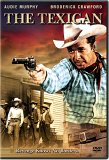| Reviews & Columns |
|
Reviews DVD TV on DVD Blu-ray 4K UHD International DVDs In Theaters Reviews by Studio Video Games Features Collector Series DVDs Easter Egg Database Interviews DVD Talk Radio Feature Articles Columns Anime Talk DVD Savant Horror DVDs The M.O.D. Squad Art House HD Talk Silent DVD
|
DVD Talk Forum |
|
|
| Resources |
|
DVD Price Search Customer Service #'s RCE Info Links |
|
Columns
|
|
|
Texican, The
Audie Murphy, in fresh-from-the-dry-cleaners wardrobe, is Jess Carlin, a reformed gunfighter living in Mexico because of a $500 price on his head north of the Rio Grande. Nonetheless, he's compelled to cross over into America after his newspaperman brother, Roy (Victor Vilanova), is murdered along with with Bernie Banta (Georges Rigaud) by land baron Luke Starr (Broderick Crawford), though the deed is set-up to suggest Roy and Banta shot one another.
Jess faces the expected reluctance from the frightened townsfolk and numerous attempts on his life by Luke's various henchmen (Aldo Sambrell, Antonio Molino Rojo, and Juan Antonio Peral among them). He also finds a love interest in Kit O'Neal (Diana Lorys), the daughter of Starr's late bookkeeper; Starr, of course, wants Kit for himself. Jess also meets Sandy Adams, Roy's rancher girlfriend.
The Texican is unambitious with a thin story stretched out over its 86 1/2 minutes. (As with many European productions from the period, there are also roughly two minutes of exit music.) The film was part of the so-called "geezer Western" sub-genre: lower-budget oaters made in the 1960s featuring aging talent long associated with such films. They were cheap enough that, at least until the proliferation of Spaghettis came along, were very modestly profitable for studios like Columbia and Paramount.
Audie Murphy came to fame as World War II's most-decorated G.I., but he also carved a niche starring in Westerns and war movies, and while he had a certain agreeable charm he was also somewhat wooden with a very limited range. In The Texican, Jess is a standard Western type, the reformed "bad" gunslinger seeking vengeance after a "good" family member's murder, but the darker side of Jess's character is beyond Murphy's abilities and indistinguishable from scenes where he's supposed to be charming and likeable.
After four years as Chief Dan Mathews on TV's Highway Patrol, Broderick Crawford went to Europe, adding questionable luster to such films as the delightfully goofy Goliath and the Dragon (La Vendetta di Ercole, 1960). Unlike his scenery-chewing performance in that film, Crawford seems bored with what amounts to a one-note villain part here, mumbling though his role.
The rest of the cast consists of busy European character players. Lorys had starred in Jess Franco's The Awful Dr. Orloff (1962) and was busy in films of all sorts through the 1970s. Sambrell appeared in all of Sergio Leone's Westerns and other genre classics like A Bullet for the General, as well as outside productions as diverse as Doctor Zhivago and Shaft in Africa. Nico Fidenco, who wrote the imitation Morricone score, later did the music for innumerable Emmanuelle films. Except for Murphy and Crawford, everyone mouths their lines in English but all are dubbed, and the disembodied effect of this doesn't help the movie much. (Even Murphy and Crawford appear to have had a few scattered lines looped by other actors.)
Director Lesley Selander was near the end of a 30-year, 125-plus feature film run. A veteran of more than two dozen Hopalong Cassidy films in the 1930s and '40s, as well as other miscellaneous B-Westerns (and occasional offbeat assignments like The Catman of Paris and Flight to Mars), Selander worked fast and competently, but was no auteur.
Video & Audio
Filmed in Techniscope, The Texican is a very good 16:9 anamorphic transfer that retains the original 2.35:1 original aspect ratio. There is some mild speckling and a few other modest flaws but overall the image is very solid and Columbia TriStar Home Video should be thanked for doing good work on such a minor title. The mono sound (English only), with all the dialogue likely looped in post-production, is on par with films of this type and era. Optional Japanese subtitles are included, but not the usual French and Spanish. There are no Extra Features, not even a trailer.
Parting Thoughts
The Texican is the kind of Western that people who don't like such films imagine all Westerns to be like. Die-hard fans of the genre (and Audie Murphy, who still has a cult following 34 years after his untimely death) will want to check it out, but it's also instantly forgettable.
Stuart Galbraith IV is a Los Angeles and Kyoto-based film historian whose work includes The Emperor and the Wolf -- The Lives and Films of Akira Kurosawa and Toshiro Mifune. His new book, Cinema Nippon will be published by Taschen in 2005.
|
| Popular Reviews |
| Sponsored Links |
|
|
| Sponsored Links |
|
|
| Release List | Reviews | Shop | Newsletter | Forum | DVD Giveaways | Blu-Ray | Advertise |
|
Copyright 2024 DVDTalk.com All Rights Reserved. Legal Info, Privacy Policy, Terms of Use,
Manage Preferences,
Your Privacy Choices | |||||||















